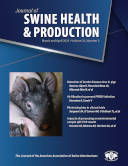Abstract:

Maximizing value and minimizing waste in clinical trial research in swine: Design features to minimize bias
Jan M. Sargeant, DVM, MSc, PhD, FCAHS; Annette M. O’Connor, BVSc, MVSc, DVSc, FANZCVS; Terri L. O’Sullivan, DVM, PhD; Alejandro Ramirez, DVM, MPH, PhD, DACVPM
Complete article is available online.
PDF version is available online.
Researchers designing trials should implement design features intended to reduce bias. These include random allocation to intervention groups and blinding of caregivers and outcome assessors. The method of generating the random sequence should be reported, as well as methods for stratification or blocking if used. When blinding is not possible, objectively measured outcomes should be used. Allocation concealment may not be essential when all eligible pens or animals are enrolled and there is no preference for intervention group. An a priori trial protocol should be made publicly available, and results for all outcomes evaluated should be reported.
Keywords: randomization, allocation concealment, blinding, bias
![]() Cite as: Sargeant JM, O’Connor AM, O’Sullivan TL, Ramirez A. Maximizing value and minimizing waste in clinical trial research in swine: Design features to minimize bias. J Swine Health Prod 2023;31(2):82-86.
Cite as: Sargeant JM, O’Connor AM, O’Sullivan TL, Ramirez A. Maximizing value and minimizing waste in clinical trial research in swine: Design features to minimize bias. J Swine Health Prod 2023;31(2):82-86.
Search the AASV web site for pages with similar keywords.
